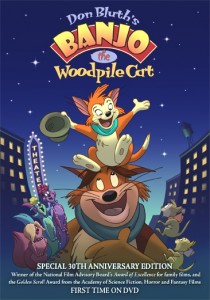Commentary 31 Mar 2009 07:52 am
Bluth & Banjo – 1
 - Recently on the DVD market is the high quality version of Banjo, the Woodpile Cat. This film merits some attention as being a link from the stasis of animation in the 70s to the somewhat Golden period in the early 80s.
- Recently on the DVD market is the high quality version of Banjo, the Woodpile Cat. This film merits some attention as being a link from the stasis of animation in the 70s to the somewhat Golden period in the early 80s.
A small group of people, who were employed in the Disney animation system, began meeting after hours and weekends to develop their own talents to a greater extent than they felt they were achieving within the confines of the Disney system.
Led by Don Bluth, Gary Goldman and John Pomeroy, this small ever-mutating group connected with animation exercises for a film called “The Piper” based on a poem. However, the story for this piece kept growing, and they knew they’d never complete it unless it were a feature.
Changing course they came upon the story of Banjo, the Woodpile Cat, and the film slowly entered its development going into production in 1975. As this production started developing it became evident that the trio –  Bluth, Goldman and Pomeroy – would have to move off the Disney lot, and they quit. Immediately thereafter, a larger group joined them including animators: Lorna Pomeroy, Heidi Guedel, Linda Miller, Emily Juliano; assistant animators: Frank Jones, Dave Spafford, Vera Law and Sally Voorhees and Diane Landau.
Bluth, Goldman and Pomeroy – would have to move off the Disney lot, and they quit. Immediately thereafter, a larger group joined them including animators: Lorna Pomeroy, Heidi Guedel, Linda Miller, Emily Juliano; assistant animators: Frank Jones, Dave Spafford, Vera Law and Sally Voorhees and Diane Landau.
This staff started working as a close knit team in the garage behind Don Bluth’s home. Interest was ignited by a group called Aurora, composed of ex-Disney executives, in working together with the Bluth team. They also presold the forthcoming film to ABC, and there was talk of a feature.
They were a tight group working in cramped corners, but they used every resource they could. Without seeking outside help, they were able to add a number of key people who would help complete the project. It took almost five years for them to finish Banjo.
- This attention certainly caught the eye of those of us in New York. Animation back in the 70s was something of a wasteland. In New York there was Ralph Bakshi who had done a couple of features, ran into trouble with Coonskin and took off for LA to continue a spotty career. There was also the Hubley Studio doing their annual, stunning shorts and not much that grabbed widespread attention in the market. Disney was producing vapid charmless films.
Suddenly, there was this insurrection, and a new studio was born in love of the medium. I can’t exaggerate the excitement this caused in the “young” animatorsat the time – even 3000 miles way. We couldn’t have asked for more to watch in our gossip pipe lines.
We’d heard and read about Banjo the Woodpile Cat, but before too long, they were talking about Mrs. Frisby and the Secret of Nimh. I think I read every bit of PR I could find. Mind you, I had no interest in going to LA, so the studio wasn’t a place where I might work; it was the hope that something, anything would put some pepper into the laconic industry.
I remember having just finished Morris’s Disappearing Bag for Weston Woods and starting Doctor DeSoto when I had a conversation with my composer, Ernest Troost, about a publicity puff piece I’d read about all the methods the Bluth people were using to revitalize a dying medium.
It was exciting. Change was in the air.
To be concluded tomorrow.
.
All images come from the dvd and are
copyright © 2009 Don Bluth Films, All Rights Reserved.
.



on 31 Mar 2009 at 6:08 pm 1.Oswald Iten said …
Thanks for the original NYT article. I like it that you show historical documents the way they originally appeared.
When I saw “Banjo” for the first time a few days ago it made me want to revisit “Secret of NIMH” as well as “The Rescuers”.
For too long I’ve just thought about Don Bluth films in connection with style and flashy special effects. But it’s interesting to see to what extent they succeeded to make films with “heart” and “more insight into human life” as is often mentioned in interviews.
on 09 Apr 2009 at 8:04 am 2.Andrew said …
“more insight into human lifeâ€
For example??